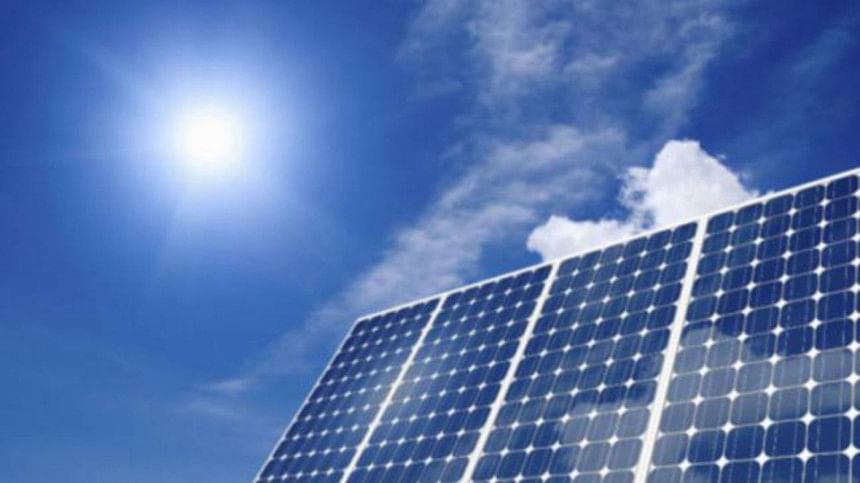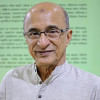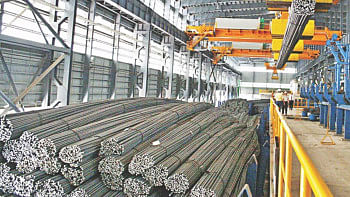Why is solar power development so slow in Bangladesh?

The pace at which renewable energy including solar and wind is being developed worldwide suggests that these will overtake the fossil fuels (oil, gas, coal) as dominant sources in power generation in a shorter time frame than previously forecasted. In mid-1990s renowned energy experts predicted that oil, gas and coal will remain the predominant fuel for power generation until 2030. This will give way to natural gas becoming the universal fuel in 2050; the battle between fossil fuels and renewable (solar and wind) for dominance over world energy market will begin in earnest by 2060 and the battle will clearly swing in favour of renewables by 2070.
The scientists are beginning to believe that this will happen in a timeframe earlier than suggested above. There are two reasons for such notion: firstly, the advances in solar and wind technology have been and will continue to be fast moving, thus lowering the cost and becoming logistically more acceptable and secondly, the green lobby has successfully influenced the governments worldwide to be more proactive towards the campaign for renewable replacing fossil fuels .
Bangladesh has a success story in developing off-grid rooftop solar power known as solar home system (SHS) which has given electricity to a large number of people living in rather remote off-grid areas and who would not have electricity otherwise. More than four million SHS installed domestically have uplifted the lifestyle of these impoverished people by providing small-scale power at their homes. But in the context of national power demand and generation, the contribution of SMS is tiny, a mere 250 megawatt, which is only two percent of the total power generation capacity in the country. In fact, in the solar industry worldwide, large-scale solar power generation essentially means on-grid solar (grid-connected).
According to the government plan, renewable sources should provide about 10 percent of the total power generation capacity by 2021, meaning 2400MW power generation from renewable sources. The prospect of wind power (presently total installed capacity is 2MW), bio-energy (present installed capacity 1MW) or new hydro-power have been limited in Bangladesh and therefore, growth of renewable energy in Bangladesh will rely mainly on the development of on-grid solar power. At present the on-grid solar power generation capacity amounts to 15MW (Sreda 2018) including one well-publicised solar park with 3MW capacity built on 8 acres of land in Sarishabari in Jamalpur district.
With such low level of development it would be impractical to believe that the growth of solar power would reach anything near the projected target by 2021. To date, the government has approved proposals for establishing 19 on-grid solar power parks submitted by different private companies. Individually the proposed solar parks have generation capacity ranging from 5MW to 200MW and the cumulative power generation of all these installations would amount to 1070MW. Among these, only six companies have so far reached the final stage of negotiations by signing power purchase agreement (PPA) and implementation agreement with the government. According to the prevailing regulation, a company has to complete the construction and start power generation within one and a half years from signing the PPA and IA. Unfortunately, none of the companies could complete construction and start power generation till date although the deadlines have passed. From the above, it appears that the development of the on-grid solar has so far failed to provide a realistic hope of achieving projected government target.
What holds Bangladesh back in developing solar power? Realistically, there are a number of reasons that are restricting expected growth of on-grid solar. One of the major challenges is the difficulty of acquiring land. As per the government rule, no agricultural land can be used for solar power project. Bangladesh is a densely populated fertile agricultural land and non-agricultural unused land is not easily available. A 100MW solar park for example would require about 300 acres of land. It is expected that the efficiency of the solar panel will increase in future through new technological advances thus requiring lesser area for generating per unit of power. But until that happens, acquiring land will be a major problem for rapid expansion of on-grid solar in Bangladesh.
Another drawback in developing on grid solar in Bangladesh is lack of governmental incentive. The companies which are engaged in negotiations and implementation of solar park opine that solar industry in Bangladesh is still in an immature and infant stage and requires incentives from the local authorities. A major point in this is fixing the tariff of the produced power. Over the last few years the cost of solar power generation and therefore the tariff offered has moved progressively downward as seen in India and China for example. In India, solar power was offered a tariff of 19 cents (Tk 15.80) per unit in 2010 and this has come down to 5 cents (Tk 4) in 2017. Nevertheless, how logical will it be to take the Indian experience directly to fix the tariff in Bangladesh at this moment may be questionable for a number of reasons.
Firstly there are abundant areas left barren in India which are comparatively easy to procure (both in cost and logistic considerations) for solar park developments, including large span of desserts. This is not so in Bangladesh. Also the facts that the average sun shine time is 5.5 to 6.5 hour per day in India compared to 4 to 4.5 hours per day in Bangladesh. Furthermore India has by now achieved a solar generation capacity of 20,000MW and thus boasts a well trained and qualified work force of its own. On the contrary, Bangladesh has to depend essentially on foreign experts for development of solar parks. All the above factors let India generate solar power at lesser cost than that of Bangladesh.
The organisations engaged in building solar power plants in Bangladesh opine that unless incentive in solar power tariff is given, their effort to develop solar industry would not be economically feasible. It appears that the companies consider 9 cent per unit tariff offered by the government too low a price to build a solar plant and make a profit. Ideally, the government negotiators should be good at offering tariff which is biased towards the people and not towards the companies. But solar power industry in Bangladesh is yet to stand on its feet and at this initial stage it needs incentive to grow to a reasonable strength. Tariff incentive is perhaps a vital area which makes a company decide its future in Bangladesh.
From the above discussion it appears that the rapid growth of renewable energy in power generation will change the world for better in not so distant future. The use of traditional fuels oil gas and coal will gradually decrease to be replaced by renewable solar winds etc till a time when the formers will find their place in history book. Bangladesh does not have an option to remain isolated when rest of the world embraces a future with smarter and cleaner renewable energy for their power. The challenges in developing renewables may be high, but it is the government which should extend its hand to help it grow in the initial stage.
Dr Badrul Imam is a professor and an energy expert.

 For all latest news, follow The Daily Star's Google News channel.
For all latest news, follow The Daily Star's Google News channel. 








Comments